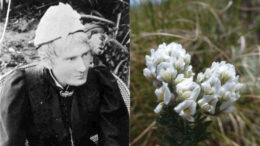 As my “Extinction Countdown” column approaches its 20th anniversary, I’m revisiting some past stories that still resonate today. Here’s one that’s been adapted, updated and expanded from an article originally published in April 2016.
As my “Extinction Countdown” column approaches its 20th anniversary, I’m revisiting some past stories that still resonate today. Here’s one that’s been adapted, updated and expanded from an article originally published in April 2016.
Mary Elizabeth Barber, South Africa’s first woman ornithologist and botanist and a correspondent of Charles Darwin, described dozens of birds, plants and insect species over the course of her lifetime. More than a century after her death in 1899, several of those species still bear her name.
Barber herself, however, has all but been forgotten, like so many pioneering women scientists whose accomplishments have been eclipsed by their male colleagues.
But one species Barber discovered in 1862 may help to change that.
The striking plant called Mrs. Barber’s beauty (Lotononis harveyi) has long been a bit of a mystery. Although the samples Barber collected can still be examined in museums, the living flowers eluded rediscovery for more than a century.
But flash forward a few decades, and the beautiful white flower with densely hairy petals was finally found once again and photographed for the very first time in 2014.
Vincent Ralph Clark of Rhodes University in South Africa actually rediscovered Lotononis harveyi in 2009 — 147 years after Barber’s description was first published — while conducting field work in the Great Winterberg mountain range for his Ph.D. At the time he didn’t realize exactly what he had seen. A sample he collected that year was reexamined in 2014 by University of Johannesburg botany professor Ben-Erik Van Wyk, who suggested the white flower could be the lost species.
With that encouragement, Clark returned to the Winterbergs later that year and extended his search. He not only found the individual plant he saw in 2009 but also located several others. The confirmed rediscovery was finally published in 2016 in the journal PhytoKeys.
Clark also found that Mrs. Barber’s beauty probably eluded rediscovery not just because of its remote location but also due to its slow growth rate and rarity. He found just six specimens, two of which had damaged stems, and no evidence of recruitment of the next generation of plants. This, along with potential threats from fire and livestock, led him to suggest that the flower should be considered critically endangered.
There could be more than just those six plants out there, of course, since the steep mountain does a pretty good job of keeping its secrets. Additional expeditions would be required to find them, as well as to learn more about the elusive Mrs. Barber’s beauty. The 2016 paper noted that we know “virtually nothing about its biology.” That means that although this rare flower has now finally been found once again, we don’t know what it would take to preserve it or its habitat.
Eight years later we still don’t know much. No additional scientific papers have been published about Mrs. Barber’s beauty, and no observations of the species have been recorded on iNaturalist. However, the South African National Biodiversity Institute officially declared it critically endangered in 2021, noting that it’s “potentially threatened by grazing, fire, and competition from alien invasive species, which occur at low densities in some parts of its range.” The assessment still noted just six known examples of the plant.
But at least it’s been found. That’s just one step toward reaffirming the legacy of Mary Elizabeth Barber, whose scientific writings and artwork have enjoyed a bit of a posthumous resurgence since the rediscovery of the plant that bears her name. Historian Tanja Hammel published a 360-page monograph about her in 2019, which notes:
She would ultimately paint many more than the one hundred watercolors of plants, butterflies, birds, reptiles and landscapes that remain to this day. Sixteen of her scientific articles as well as a volume of poems were published. To achieve the publication of her articles, she corresponded with some of the most distinguished British experts in her fields, such as the entomologist Roland Trimen, the botanists William Henry Harvey and Joseph Dalton Hooker, and the ornithologist Edgar Leopold Layard. In doing so, she contributed not only to botany but also to entomology, ornithology, geology, archaeology and paleontology.
Meanwhile a 303-page collection of Barber’s correspondence — edited by Hammel, Alan Cohen, and Jasmin Rindlisbacher — was published in 2020. The book, Growing Wild — titled to symbolize “how Barber emancipated herself both from her wider social environment and from the ideal of the Victorian ‘angel in the house’ in order to publish her work and have her research archived and her life and career remembered” — reveals her pioneering feminism and unflinching determination.
At the same time, these new examinations of Barber’s history and legacy also shine a light on her disturbing 19th-century colonialist attitudes. For instance, as Hammel wrote in a 2015 paper, Barber greatly benefited from traditional knowledge and labor from her African collaborators but “she silenced or obscured [their] share in her work as part of a tactic to keep her credibility among urban and metropolitan scientists and to stress her authority as local expert.”
This last aspect, which Hammel puts into a broader historic context in her monograph, darkens the legacy of Barber, as it does other naturalists of her day. That’s one reason why so many peoples’ names are being removed from the species they described.
Maybe Mrs. Barber’s beauty will one day also be renamed. For now, though, this rediscovered plant serves a reminder of a groundbreaking feminist naturalist history has all but ignored or forgotten — like so many other women in science — and who, like the flower that bears her name, should not be allowed to fade into extinction.

Get more from The Revelator. Subscribe to our newsletter.
Previously in The Revelator:
Decolonizing Species Names


